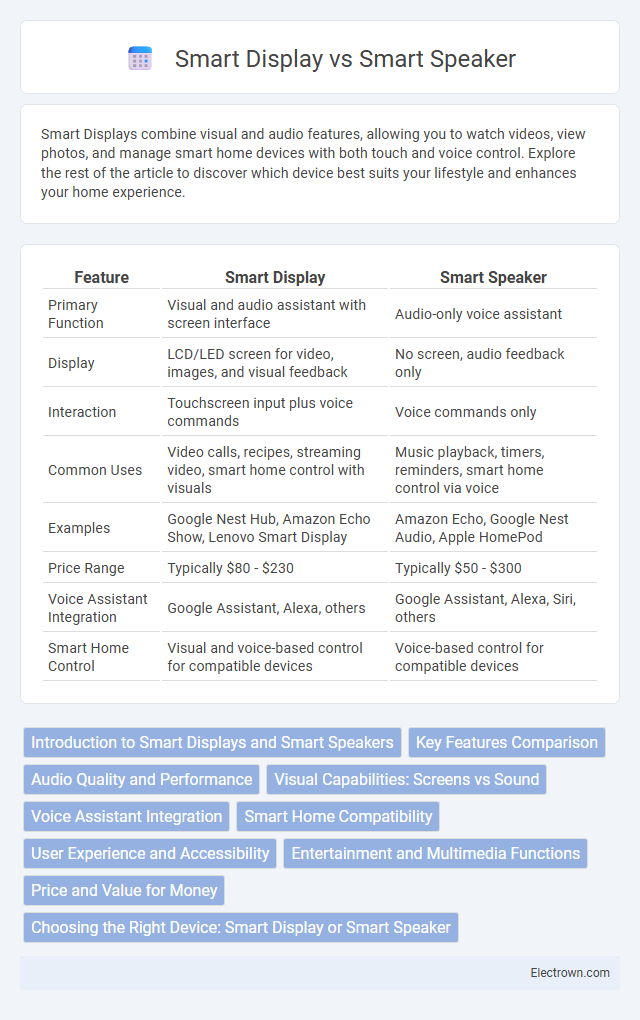Smart Displays combine visual and audio features, allowing you to watch videos, view photos, and manage smart home devices with both touch and voice control. Explore the rest of the article to discover which device best suits your lifestyle and enhances your home experience.
Table of Comparison
| Feature | Smart Display | Smart Speaker |
|---|---|---|
| Primary Function | Visual and audio assistant with screen interface | Audio-only voice assistant |
| Display | LCD/LED screen for video, images, and visual feedback | No screen, audio feedback only |
| Interaction | Touchscreen input plus voice commands | Voice commands only |
| Common Uses | Video calls, recipes, streaming video, smart home control with visuals | Music playback, timers, reminders, smart home control via voice |
| Examples | Google Nest Hub, Amazon Echo Show, Lenovo Smart Display | Amazon Echo, Google Nest Audio, Apple HomePod |
| Price Range | Typically $80 - $230 | Typically $50 - $300 |
| Voice Assistant Integration | Google Assistant, Alexa, others | Google Assistant, Alexa, Siri, others |
| Smart Home Control | Visual and voice-based control for compatible devices | Voice-based control for compatible devices |
Introduction to Smart Displays and Smart Speakers
Smart displays combine touchscreen interfaces with voice assistant capabilities, offering visual feedback, video calls, and multimedia playback alongside audio responses. Smart speakers primarily provide voice-activated assistance and high-quality audio output without a screen, focusing on hands-free control and music streaming. Both devices utilize AI assistants like Amazon Alexa, Google Assistant, or Apple Siri to enhance smart home connectivity and user interaction.
Key Features Comparison
Smart Displays combine voice assistant capabilities with a touchscreen interface, allowing you to watch videos, view photos, and control smart home devices visually. Smart Speakers focus primarily on audio interaction, providing hands-free voice commands for music playback, information retrieval, and home automation without a screen. Your choice depends on whether you prefer visual feedback and multimedia access or a more compact, audio-centric smart assistant.
Audio Quality and Performance
Smart Displays typically offer enhanced audio quality with built-in speakers designed for clear voice output and multimedia playback, often incorporating multiple speakers and better acoustics to deliver richer sound compared to Smart Speakers. Smart Speakers prioritize voice recognition and efficient sound projection for voice commands, with audio quality suitable for casual listening but generally less immersive than Smart Displays. Performance in Smart Displays balances visual processing with audio tasks, while Smart Speakers focus on optimized voice command responsiveness and seamless integration with smart home ecosystems.
Visual Capabilities: Screens vs Sound
Smart displays enhance user interaction by combining voice commands with visual feedback on vibrant screens, enabling video calls, photo viewing, and visual recipe guides. Smart speakers rely solely on sound output, delivering audio responses, music playback, and voice-activated controls without any visual interface. The choice between smart display and smart speaker depends on whether users prioritize visual information alongside audio or prefer hands-free, sound-based interaction.
Voice Assistant Integration
Smart Displays feature advanced Voice Assistant integration with visual feedback, enabling users to interact through touch, voice, and visuals for tasks like video calls, streaming, and displaying information simultaneously. Smart Speakers rely primarily on voice-only interaction, optimizing audio response and sound quality for hands-free control of smart home devices, music playback, and information queries. Voice assistants on Smart Displays provide enhanced contextual awareness and multimodal interaction, improving usability in complex commands and visual content navigation.
Smart Home Compatibility
Smart Displays offer enhanced smart home compatibility by providing visual controls for lighting, thermostats, security cameras, and other connected devices, allowing you to see and manage your smart home ecosystem more intuitively. In contrast, Smart Speakers rely solely on voice commands without visual feedback, which may limit precise interactions with complex smart home systems. Choosing a Smart Display can improve your management of smart home devices through real-time visual information and touch-screen functionality.
User Experience and Accessibility
Smart Displays enhance user experience by combining voice commands with visual feedback, allowing you to see information, watch videos, or control smart home devices more intuitively. Smart Speakers prioritize audio interaction, providing hands-free control and easy access to assistants, but lack visual context, which may limit accessibility for users with hearing impairments. Your choice depends on whether visual cues or pure voice interaction better suit your accessibility needs and daily tasks.
Entertainment and Multimedia Functions
Smart Displays combine visual and audio capabilities, offering immersive multimedia experiences such as streaming videos, displaying photos, and providing interactive content alongside voice-controlled music playback. Smart Speakers emphasize high-quality audio for music, podcasts, and voice assistant interactions, but lack a screen for visual media presentation. Your choice depends on whether you prefer enriched entertainment through visuals or primarily audio-focused functions.
Price and Value for Money
Smart displays typically cost between $80 and $230, offering visual interfaces that enhance usability through touchscreens and video capabilities, which justifies their higher price compared to smart speakers priced around $30 to $150. The added functionality of smart displays, such as video calls, recipe displays, and security monitoring, provides greater value for money for users seeking more interactive and multimedia experiences. Smart speakers are more budget-friendly and ideal for voice-controlled tasks, but smart displays deliver better value for those prioritizing versatility and visual interaction.
Choosing the Right Device: Smart Display or Smart Speaker
Selecting between a smart display and a smart speaker depends on your primary needs: smart displays offer visual interfaces for video calls, recipe guides, and entertainment, while smart speakers excel in voice-activated control and audio quality. Consider the environment and functionality--smart displays are ideal for kitchens and living rooms where screen interaction enhances usability, whereas smart speakers fit well in bedrooms or offices for hands-free, audio-focused tasks. Evaluate device compatibility with your smart home ecosystem to ensure seamless integration and optimal user experience.
Smart Display vs Smart Speaker Infographic

 electrown.com
electrown.com